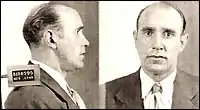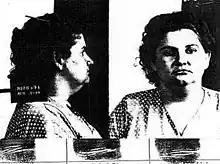Raymond Fernandez and Martha Beck
Raymond Martinez Fernandez (December 17, 1914 – March 8, 1951) and Martha Jule Beck (May 6, 1920 – March 8, 1951) were an American serial killer couple. They were convicted of one murder, are known to have committed two more, and were suspected of having killed up to twenty victims during a spree between 1947 and 1949.
Raymond Fernandez | |
|---|---|
 | |
| Born | Raymond Martinez Fernandez December 17, 1914 |
| Died | March 8, 1951 (aged 36) |
| Cause of death | Execution by electrocution |
| Occupation | Confidence trickster |
| Criminal status | Executed |
| Children | 4 (previous marriage) |
| Conviction(s) | First degree murder |
| Criminal penalty | Death |
| Details | |
| Victims | 3–20 |
Span of crimes | 1947–1949 |
| Country | United States |
| State(s) | Michigan and New York |
Martha Beck | |
|---|---|
 | |
| Born | Martha Jule Seabrook May 6, 1920 Milton, Florida, U.S. |
| Died | March 8, 1951 (aged 30) |
| Cause of death | Execution by electrocution |
| Occupation | Nurse |
| Criminal status | Executed |
| Children | 2 (previous marriages) |
| Conviction(s) | First degree murder |
| Criminal penalty | Death |
| Details | |
| Victims | 3–20 |
Span of crimes | 1947–1949 |
| Country | United States |
| State(s) | New York and Michigan |
After their arrest and trial for serial murder in 1949, Fernandez and Beck became known as the Lonely Hearts Killers for meeting their unsuspecting victims through personal ads, posted in newspaper lonely hearts columns. A number of films and television shows are based on this case.
Before the murders
Raymond Fernandez
Raymond Martinez Fernandez was born in the Territory of Hawaii to Spanish parents on December 17, 1914. Shortly thereafter, the family moved to Bridgeport, Connecticut. As a teenager, Fernandez went to work on his uncle's farm in Spain, married a young local woman named Encarnación Robles and had four children, all of whom he abandoned later in life.
After serving in the Spanish merchant navy and with British intelligence services during World War II,[1] Fernandez decided to seek a job. Shortly after boarding a ship bound for the U.S., a steel hatch fell on him, fracturing his skull and injuring his frontal lobe. The damage caused by this injury may well have affected his social and sexual behavior.[2]
Upon his release from a hospital, Fernandez stole some clothing and was subsequently imprisoned for a year, during which time his cellmate converted him to a belief in voodoo and black magic. Fernandez later claimed black magic gave him irresistible power and charm over women.[3][4]
Martha Beck
Martha Beck was born Martha Jule Seabrook on May 6, 1920, in Milton, Florida. Allegedly due to a glandular problem (then a common explanation for obesity), Beck was overweight and underwent puberty prematurely. At her trial, she claimed to have been raped by her brother and subsequently beaten by her mother, blaming Beck for the incident.[5] As a teen, Beck ran away from home to join a traveling circus; writer Truman Capote later claimed to have briefly toured with Beck when he was ten years old.
After finishing school, Beck studied nursing but had trouble finding a job due to her weight. She initially became an undertaker's assistant and prepared female bodies for burial. She soon quit that job and moved to California, where she worked in a United States Army hospital as a nurse. While living in California she eventually became pregnant, but the father of the baby refused to marry her. Single and pregnant, at a time when a social stigma existed concerning out of wedlock childbirth, Beck returned to Florida.[5]
Beck claimed that her child's father had been killed in the Pacific Campaign. The town mourned her loss and the story was published in the local newspaper.[5] Shortly after her daughter was born, she became pregnant again by a Pensacola bus driver named Alfred Beck. They married quickly and divorced six months thereafter. She gave birth to a son.[6]
Unemployed and the single mother of two young children, Beck escaped into a fantasy world, buying romance magazines and novels, and watching romantic movies. In 1946, she found employment at the Pensacola Hospital for Children. She placed a lonely hearts ad in 1947, which Raymond Fernandez answered.[6]
Murders
Fernandez visited Beck and stayed for a short time; she told everyone they were to be married. He returned to New York City while she made preparations in Florida. When she was abruptly fired from her job, Beck packed her belongings and arrived on Fernandez' doorstep in New York. Fernandez enjoyed the way she catered to his every whim, and when he learned she had left her children for him, he thought it was a sign of an unconditional love. He confessed his criminal enterprises to Beck, who quickly sent her children to the Salvation Army in order to devote herself to Fernandez without any distractions.
Beck posed as Fernandez's sister, giving him an air of respectability. Their victims, feeling more secure knowing there was another woman in the house, often agreed to stay with the pair. Beck also convinced some victims that she lived alone and that her "brother" was only a guest. She was extremely jealous and went to great lengths to make sure Fernandez and his "intended" never consummated their relationship. When he did have sex with a woman, Beck subjected both to her violent temper.
In 1949, the pair committed the three murders for which they later were convicted. Janet Fay, 66, became engaged to Fernandez and went to stay at his Long Island apartment. When Beck caught her in bed with Fernandez, she brutally struck Fay's head with a hammer in a murderous rage. Fernandez then strangled Fay. Her family became suspicious when she disappeared, and Fernandez and Beck fled.
Beck and Fernandez traveled to Byron Center Road in Wyoming Township, Michigan, a suburb of Grand Rapids, where they met and stayed with Delphine Downing, a 28-year-old widow with a two-year-old daughter. On February 28, Downing became agitated and Fernandez gave her sleeping pills to calm her. The daughter witnessed Downing's resulting stupor and began to cry, which enraged Beck. Panicked, Beck strangled the child but didn't kill her. Fernandez thought Downing would become suspicious if she saw her bruised daughter, so he shot the unconscious woman. The couple then stayed for several days in Downing's house. Again enraged by the daughter's crying, Beck drowned her in a basin of water. They buried the bodies in the basement, but suspicious neighbors reported the Downings' disappearances, leading the police to arrive at the door on March 1, 1949, and arrest Beck and Fernandez.[7]
Trial and executions
Fernandez quickly confessed. The pair vehemently denied committing seventeen murders that were attributed to them, and Fernandez tried to retract his confession, saying he made it only to protect Beck. They were extradited to New York, which still instituted the death penalty. Fay's murder was the only one for which the couple were tried, and they were both sentenced to death. They were executed at Sing Sing prison on March 8, 1951.[8]
In media
- "Lonely Hearts Killers", a 1960 episode of the American TV show Deadline, released on DVD in 2019
- The Honeymoon Killers, 1970 American cult classic about the same events
- Deep Crimson, 1996 Mexican film about the same events
- Lonely Hearts, 2006 American film about the same events
- Alleluia, 2014 Belgian-French film inspired by the same events
- A 2006 episode of the TV series Cold Case was called "Lonely Hearts", featuring a pair of killers named Martha Puck and Ramon Delgado.
See also
References
- The Lonely Hearts Killers. Trutv.com. p. 4.
- Harvey S. Levin; Eugenio Amparo; Howard M. Eisenberg; David H. Williams; Walter M. High Jr; Craig B. McArdle; Richard L. Weiner (1987). "Magnetic resonance imaging and computerized tomography in relation to the neurobehavioral sequelae of mild and moderate head injuries". Journal of Neurosurgery. 66 (5): 706–713. doi:10.3171/jns.1987.66.5.0706. PMID 3572497.
- "Serial Killers Martha Beck and Raymond Fernandez". Francesfarmersrevenge.com. March 8, 1951. Archived from the original on September 17, 2010. Retrieved 2010-09-28.
- "The Lonely Hearts Killers". Trutv.com. p. 1.
- The Lonely Hearts Killers. Trutv.com. p. 2.
- The Lonely Hearts Killers. Trutv.com. p. 3.
- Gado, Mark (2007). Death Row Women: Murder, Justice, and the New York Press. Praeger. p. 157. ISBN 978-0-275-99361-0.
- "2 'LONELY HEARTS' PAY DEATH PENALTY; Fernandez, Mrs. Beck Go to Chair in Sing Sing 2 Others Also Die for Murder". The New York Times. 1951-03-09. ISSN 0362-4331. Retrieved 2022-06-25.
Sources
- Lane, Brian and Gregg, Wilfred [1992]. The Encyclopedia Of Serial Killers. Berkley Books.
- Fuchs, Christian [1996] (2002). Bad Blood. Creation Books.
External links
- "Martha Beck & Raymond Fernandez, Lonely Hearts Killers -- the Crime Library — The Lonely Hearts Killers — Crime Library". 2015-02-09. Archived from the original on 2015-02-09. Retrieved 2023-03-25.
- Martha Beck and Raymond Fernandez at Frances Farmers Revenge